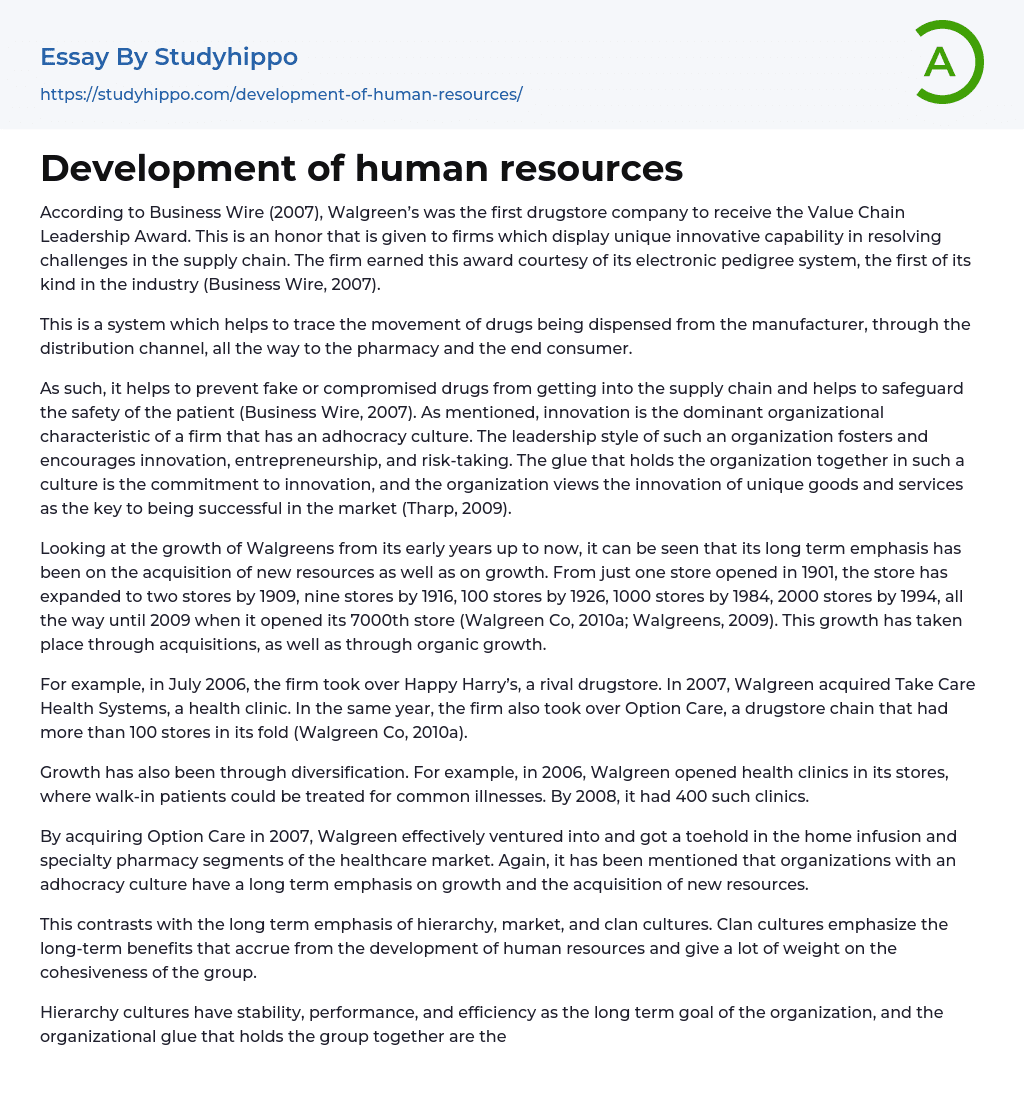According to Business Wire (2007), Walgreen’s was the first drugstore company to receive the Value Chain Leadership Award. This is an honor that is given to firms which display unique innovative capability in resolving challenges in the supply chain. The firm earned this award courtesy of its electronic pedigree system, the first of its kind in the industry (Business Wire, 2007).
This is a system which helps to trace the movement of drugs being dispensed from the manufacturer, through the distribution channel, all the way to the pharmacy and the end consumer.
As such, it helps to prevent fake or compromised drugs from getting into the supply chain and helps to safeguard the safety of the patient (Business Wire, 2007). As mentioned, innovation is the dominant organizational charact
...eristic of a firm that has an adhocracy culture. The leadership style of such an organization fosters and encourages innovation, entrepreneurship, and risk-taking. The glue that holds the organization together in such a culture is the commitment to innovation, and the organization views the innovation of unique goods and services as the key to being successful in the market (Tharp, 2009).
Looking at the growth of Walgreens from its early years up to now, it can be seen that its long term emphasis has been on the acquisition of new resources as well as on growth. From just one store opened in 1901, the store has expanded to two stores by 1909, nine stores by 1916, 100 stores by 1926, 1000 stores by 1984, 2000 stores by 1994, all the way until 2009 when it opened its 7000th store (Walgreen Co, 2010a; Walgreens, 2009).
This growth has taken place through acquisitions, as well as through organic growth.
For example, in July 2006, the firm took over Happy Harry’s, a rival drugstore. In 2007, Walgreen acquired Take Care Health Systems, a health clinic. In the same year, the firm also took over Option Care, a drugstore chain that had more than 100 stores in its fold (Walgreen Co, 2010a).
Growth has also been through diversification. For example, in 2006, Walgreen opened health clinics in its stores, where walk-in patients could be treated for common illnesses. By 2008, it had 400 such clinics.
By acquiring Option Care in 2007, Walgreen effectively ventured into and got a toehold in the home infusion and specialty pharmacy segments of the healthcare market. Again, it has been mentioned that organizations with an adhocracy culture have a long term emphasis on growth and the acquisition of new resources.
This contrasts with the long term emphasis of hierarchy, market, and clan cultures. Clan cultures emphasize the long-term benefits that accrue from the development of human resources and give a lot of weight on the cohesiveness of the group.
Hierarchy cultures have stability, performance, and efficiency as the long term goal of the organization, and the organizational glue that holds the group together are the formal rules and procedures. Market cultures espouse as their long term focus the achievement of a sustainable competitive advantage and the attainment of targets and goals which are measurable (Tharp, 2009).
On the strength of the arguments of the competing values framework, Walgreen’s organizational culture closely matches the adhocracy culture.
- Hospital essays
- Physician essays
- Health Care Provider essays
- Universal Health Care essays
- Readmission essays
- Qualities essays
- Adaptation essays
- Adventure essays
- Adversity essays
- Aging essays
- Alcohol essays
- Barbie Doll essays
- Beauty essays
- Care essays
- Carpe diem essays
- Change essays
- Chess essays
- Chicken essays
- Choices essays
- Contrast essays
- Crops essays
- Development essays
- Dream essays
- Evil essays
- Experience essays
- Family essays
- Farm essays
- Fire essays
- First Love essays
- Focus essays
- Greed essays
- Hero essays
- Holiday essays
- House essays
- Housing essays
- Humility essays
- Humor essays
- Hypocrisy essays
- Integrity essays
- Law of Life essays
- Life Changing Experience essays
- Life Experience essays
- Lifestyle essays
- Limitations essays
- Love Story essays
- Mother Tongue essays
- Motherhood essays
- My Neighborhood essays
- Myself essays
- Mystery essays




